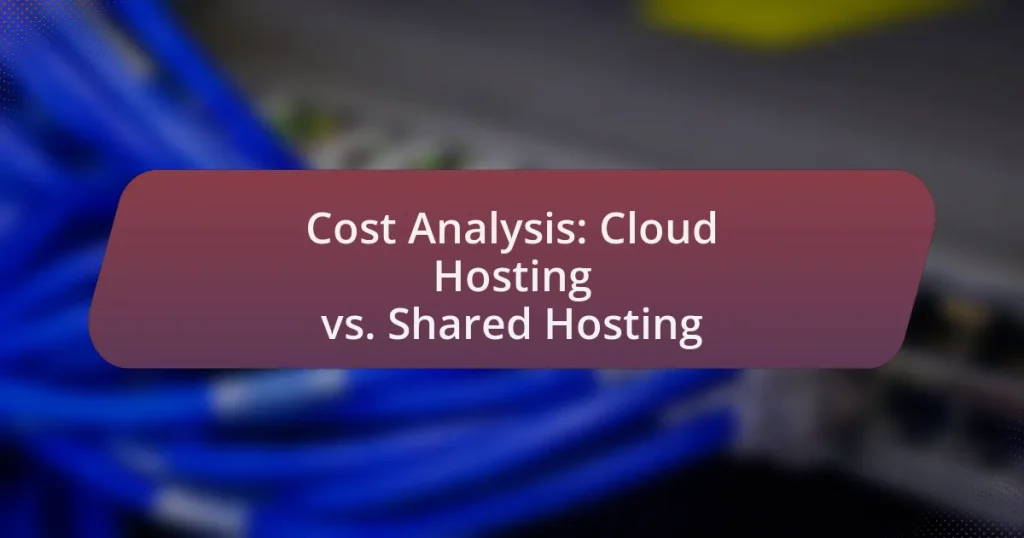Cost analysis is a critical evaluation of the expenses associated with cloud hosting and shared hosting, focusing on their financial viability for businesses. Cloud hosting generally incurs higher costs due to its scalable resources and pay-as-you-go pricing model, while shared hosting offers lower fixed costs with limited performance. The article explores the fundamental differences between these hosting types, their key characteristics, and the importance of cost analysis in decision-making. It also examines the direct costs, pricing structures, and potential long-term financial implications of each hosting option, providing insights into how businesses can effectively manage their hosting expenses.
What is Cost Analysis in the Context of Cloud Hosting vs. Shared Hosting?
Cost analysis in the context of cloud hosting versus shared hosting involves evaluating the total expenses associated with each hosting model to determine their financial viability. Cloud hosting typically incurs higher costs due to its scalable resources, pay-as-you-go pricing, and advanced features, which can lead to variable monthly expenses based on usage. In contrast, shared hosting offers a lower fixed cost, as multiple users share server resources, resulting in predictable pricing but limited performance and scalability. According to a report by HostingAdvice, cloud hosting can range from $10 to $500 per month depending on resource usage, while shared hosting generally costs between $2.75 and $10 per month, illustrating the significant cost difference between the two models.
How do Cloud Hosting and Shared Hosting differ fundamentally?
Cloud hosting and shared hosting fundamentally differ in their resource allocation and scalability. Cloud hosting utilizes a network of virtual servers that draw resources from a centralized pool, allowing for dynamic scaling based on demand, while shared hosting involves multiple websites sharing a single server’s resources, leading to potential performance limitations. This distinction is crucial as cloud hosting offers greater reliability and flexibility, accommodating traffic spikes without downtime, whereas shared hosting may struggle under heavy loads, impacting website performance.
What are the key characteristics of Cloud Hosting?
Cloud hosting is characterized by its scalability, flexibility, reliability, and cost-effectiveness. Scalability allows users to easily adjust resources based on demand, enabling businesses to accommodate traffic spikes without downtime. Flexibility is evident in the ability to choose various configurations and services tailored to specific needs. Reliability is ensured through the use of multiple servers, which minimizes the risk of downtime; if one server fails, others can take over seamlessly. Cost-effectiveness is achieved through a pay-as-you-go model, where users only pay for the resources they consume, making it a financially viable option for many businesses. These characteristics collectively make cloud hosting a preferred choice for organizations seeking efficient and adaptable hosting solutions.
What are the key characteristics of Shared Hosting?
Shared hosting is characterized by multiple websites being hosted on a single server, which leads to cost efficiency and resource sharing. This setup allows users to benefit from lower prices, as the server’s resources, such as CPU and RAM, are distributed among all hosted sites. Additionally, shared hosting typically offers user-friendly management tools, making it accessible for beginners without extensive technical knowledge. Security measures are generally provided by the hosting provider, although the shared environment can pose risks if one site is compromised. Overall, shared hosting is ideal for small businesses or personal websites with moderate traffic, due to its affordability and ease of use.
Why is Cost Analysis important for businesses choosing between Cloud and Shared Hosting?
Cost analysis is crucial for businesses choosing between cloud and shared hosting because it directly impacts their budget and resource allocation. By evaluating the total cost of ownership, including initial setup, ongoing maintenance, and scalability, businesses can make informed decisions that align with their financial goals. For instance, cloud hosting typically incurs higher upfront costs but offers greater flexibility and scalability, while shared hosting is more affordable but may limit performance and growth potential. Understanding these financial implications allows businesses to select the hosting solution that best meets their operational needs and long-term objectives.
How can cost impact the decision-making process?
Cost significantly impacts the decision-making process by influencing budget allocation and prioritization of resources. In the context of cloud hosting versus shared hosting, the cost of each option can determine which service a business chooses based on its financial constraints and expected return on investment. For instance, cloud hosting typically incurs higher costs due to its scalability and performance benefits, while shared hosting is more affordable but may limit functionality and speed. According to a study by Gartner, organizations that prioritize cost in their IT decisions often experience a 20-30% variance in operational efficiency, highlighting the critical role of cost in shaping strategic choices.
What are the long-term financial implications of each hosting type?
Cloud hosting typically incurs higher long-term costs due to its scalability and resource allocation, while shared hosting offers lower initial expenses but can lead to increased costs as traffic grows. Cloud hosting allows businesses to pay for resources as needed, which can lead to cost efficiency for fluctuating workloads; however, over time, these costs can accumulate significantly, especially for high-traffic sites. In contrast, shared hosting has a fixed cost structure, making it budget-friendly initially, but it may require upgrades or migration to more expensive plans as a business expands, potentially leading to higher long-term expenses. According to a study by HostingAdvice, businesses that outgrow shared hosting often face migration costs and downtime, which can further impact financial stability.
What are the direct costs associated with Cloud Hosting?
The direct costs associated with cloud hosting include subscription fees, data storage costs, bandwidth charges, and additional service fees for features like backups and security. Subscription fees typically vary based on the service provider and the level of resources allocated, such as CPU, RAM, and storage. Data storage costs are incurred based on the amount of data stored in the cloud, often charged per gigabyte. Bandwidth charges apply when data is transferred in and out of the cloud, which can lead to additional costs depending on usage levels. Additional service fees may arise for optional features, such as enhanced security measures or automated backups, which can further increase the overall expense of cloud hosting.
What pricing models are commonly used in Cloud Hosting?
Commonly used pricing models in cloud hosting include pay-as-you-go, reserved instances, and spot pricing. Pay-as-you-go allows users to pay only for the resources they consume, making it flexible and cost-effective for varying workloads. Reserved instances require users to commit to a specific amount of resources for a set period, often resulting in lower costs compared to on-demand pricing. Spot pricing enables users to bid on unused cloud capacity, which can lead to significant savings but comes with the risk of resource availability. These models cater to different business needs and usage patterns, providing options for cost management in cloud hosting environments.
How do pay-as-you-go models work in Cloud Hosting?
Pay-as-you-go models in cloud hosting charge users based on their actual resource consumption rather than a fixed fee. This model allows businesses to scale their usage up or down according to demand, ensuring they only pay for what they use, such as storage, bandwidth, and processing power. For instance, Amazon Web Services (AWS) and Microsoft Azure utilize this model, enabling users to monitor their usage in real-time and adjust their services accordingly. This flexibility can lead to cost savings, as companies avoid overpaying for unused resources, making it a popular choice for businesses with fluctuating workloads.
What are the costs associated with reserved instances in Cloud Hosting?
The costs associated with reserved instances in cloud hosting typically include an upfront payment, a commitment to a specific instance type and region, and ongoing hourly charges that are lower than on-demand pricing. Reserved instances often require a one- or three-year commitment, which can lead to significant savings compared to pay-as-you-go pricing. For example, AWS offers reserved instances that can save up to 75% compared to on-demand rates, depending on the instance type and payment option selected.
What additional costs should be considered in Cloud Hosting?
Additional costs in cloud hosting include data transfer fees, storage costs, and potential charges for additional services such as backups and security features. Data transfer fees can arise when moving data in and out of the cloud, often charged per gigabyte. Storage costs depend on the amount of data stored and the type of storage used, with options like standard, infrequent access, or archival storage, each having different pricing structures. Additionally, services like automated backups, enhanced security measures, and technical support may incur extra charges, which can significantly impact the overall cost of cloud hosting.
How do data transfer fees affect overall costs?
Data transfer fees significantly increase overall costs in cloud hosting compared to shared hosting. In cloud hosting, providers often charge based on the amount of data transferred in and out of their services, which can lead to substantial expenses, especially for high-traffic websites. For instance, a cloud provider may charge $0.10 per GB of data transferred, and if a website transfers 1,000 GB in a month, the total cost would be $100 solely for data transfer. In contrast, shared hosting typically includes data transfer in a flat monthly fee, making it more predictable and often cheaper for users with lower data needs. This difference in pricing structures illustrates how data transfer fees can escalate costs in cloud hosting environments, impacting budget considerations for businesses.
What are the costs related to scaling resources in Cloud Hosting?
The costs related to scaling resources in Cloud Hosting primarily include variable pricing based on usage, which encompasses compute power, storage, and data transfer. Cloud providers typically charge for additional resources on a pay-as-you-go basis, meaning that as demand increases, costs rise accordingly. For instance, Amazon Web Services (AWS) charges for compute instances based on the number of hours they are running, while storage costs are calculated based on the amount of data stored and accessed. Additionally, scaling may incur costs related to load balancing and network traffic, which can further increase expenses as more resources are utilized. This pricing model allows businesses to efficiently manage costs but can lead to unpredictable expenses if resource scaling is not monitored closely.
What are the direct costs associated with Shared Hosting?
The direct costs associated with shared hosting typically include monthly or annual subscription fees, domain registration fees, and additional charges for features such as SSL certificates or backups. Shared hosting plans generally range from $2 to $10 per month, depending on the provider and the features included. Domain registration usually costs around $10 to $15 per year. Additional services, like SSL certificates, can add $5 to $100 annually, depending on the level of security required. These costs are essential for maintaining a website on a shared hosting platform, where multiple users share the same server resources.
What pricing structures are typical for Shared Hosting?
Typical pricing structures for shared hosting include monthly, annual, and multi-year plans. Monthly plans often range from $2 to $10, while annual plans can offer discounts, typically costing between $20 and $100 per year. Multi-year plans may provide even greater savings, sometimes reducing the total cost to as low as $50 for three years. These structures are designed to accommodate varying customer needs and budgets, making shared hosting an accessible option for individuals and small businesses.
How do monthly subscription fees work in Shared Hosting?
Monthly subscription fees in shared hosting are typically charged on a recurring basis, allowing users to pay for hosting services each month. These fees cover the cost of server resources, maintenance, and support shared among multiple users, which keeps the price lower compared to dedicated hosting. For example, a standard shared hosting plan may range from $2 to $10 per month, depending on the provider and features included, such as storage space, bandwidth, and customer support. This pricing model enables users to budget their expenses effectively while accessing web hosting services without significant upfront costs.
What are the costs for additional features in Shared Hosting plans?
The costs for additional features in Shared Hosting plans typically range from $5 to $50 per month, depending on the specific feature and the hosting provider. Common additional features include increased storage, enhanced security options, dedicated IP addresses, and premium support services. For instance, adding a dedicated IP address may cost around $3 to $5 monthly, while enhanced security features can range from $10 to $30 per month. These costs can vary significantly based on the hosting provider’s pricing structure and the level of service offered.
What hidden costs might arise with Shared Hosting?
Hidden costs that might arise with shared hosting include limitations on resources, potential overage fees, and costs associated with upgrading services. Shared hosting typically allocates limited bandwidth and storage, which can lead to additional charges if a website exceeds these limits. Furthermore, if a website experiences high traffic, it may require an upgrade to a more expensive plan, incurring extra costs. Security features, such as SSL certificates or backups, may also not be included in the base price, leading to unforeseen expenses. According to a study by HostingAdvice, 60% of users reported unexpected costs related to resource limitations and security features in shared hosting plans.
How can overage charges impact the overall budget?
Overage charges can significantly impact the overall budget by increasing costs beyond the initially planned expenses. In cloud hosting, for instance, exceeding allocated resources such as bandwidth or storage can lead to additional fees that were not accounted for in the original budget. According to a study by Gartner, organizations can face up to 30% higher costs due to unanticipated overage charges in cloud services. This unexpected financial burden can disrupt cash flow and hinder the ability to allocate funds for other essential business operations.
What are the potential costs of limited resources in Shared Hosting?
The potential costs of limited resources in Shared Hosting include reduced website performance, increased downtime, and potential loss of revenue. When multiple websites share the same server resources, high traffic on one site can lead to slower loading times for others, negatively impacting user experience and search engine rankings. Additionally, if server resources are insufficient, websites may experience outages, which can result in lost sales opportunities; studies show that even a one-second delay in page load time can lead to a 7% reduction in conversions. Furthermore, businesses may incur additional costs if they need to upgrade to a more robust hosting solution to mitigate these issues, leading to higher long-term expenses compared to more scalable options like cloud hosting.
How do the costs of Cloud Hosting and Shared Hosting compare?
Cloud hosting typically incurs higher costs compared to shared hosting. Shared hosting often ranges from $2 to $10 per month, making it an economical choice for small websites. In contrast, cloud hosting can start at around $10 per month and can exceed $100 per month depending on resource usage and scalability needs. This price difference is due to the dedicated resources, enhanced performance, and flexibility that cloud hosting offers, which are not available in shared hosting environments.
What are the key factors influencing the cost comparison?
The key factors influencing the cost comparison between cloud hosting and shared hosting include resource allocation, scalability, performance, and support services. Resource allocation affects cost as cloud hosting typically offers dedicated resources, leading to higher expenses compared to shared hosting, where resources are distributed among multiple users. Scalability is another factor; cloud hosting allows for on-demand resource adjustments, which can incur additional costs, while shared hosting has fixed resources, limiting flexibility but often resulting in lower costs. Performance impacts cost as cloud hosting generally provides better speed and uptime, justifying its higher price point. Lastly, support services vary, with cloud hosting often including more comprehensive support options, which can influence overall costs.
How does resource allocation affect cost differences?
Resource allocation significantly impacts cost differences by determining how efficiently resources are utilized in various hosting environments. In cloud hosting, resources such as CPU, memory, and storage are dynamically allocated based on demand, leading to cost savings during low usage periods. Conversely, shared hosting allocates fixed resources among multiple users, which can result in higher costs per user when demand exceeds capacity, as users may need to upgrade to more expensive plans to accommodate their needs. Studies show that cloud hosting can reduce operational costs by up to 30% compared to traditional shared hosting due to its scalable nature and pay-as-you-go pricing model.
What role does performance play in cost evaluation?
Performance is a critical factor in cost evaluation as it directly influences the value derived from a hosting solution. In the context of cloud hosting versus shared hosting, higher performance typically correlates with increased costs due to enhanced resources, scalability, and reliability. For instance, cloud hosting often provides superior uptime and faster load times, which can lead to better user experiences and potentially higher revenue for businesses. Studies have shown that websites with faster load times can see conversion rates increase by up to 7%, illustrating how performance impacts financial outcomes. Therefore, when evaluating costs, it is essential to consider how performance metrics affect overall value and return on investment.
What are the potential savings or expenses in switching from Shared to Cloud Hosting?
Switching from Shared to Cloud Hosting can lead to potential savings in scalability and performance but may incur higher initial expenses. Cloud Hosting typically offers pay-as-you-go pricing, allowing businesses to only pay for the resources they use, which can reduce costs during low-traffic periods. In contrast, Shared Hosting often has fixed pricing regardless of resource usage, which can be less economical for growing websites. However, the initial setup and ongoing management costs for Cloud Hosting can be higher due to the need for more advanced infrastructure and potentially higher technical support fees. According to a report by Gartner, organizations can save up to 30% on operational costs by utilizing cloud services effectively, but they must also consider the upfront investment in cloud architecture.
How can businesses calculate potential ROI when switching?
Businesses can calculate potential ROI when switching by comparing the total costs and benefits associated with the new option against the current one. This involves identifying all relevant costs, such as subscription fees, implementation expenses, and operational costs, while also estimating the expected benefits, including increased efficiency, scalability, and potential revenue growth.
For instance, a study by Gartner indicates that companies can achieve up to 30% cost savings by migrating to cloud hosting due to reduced infrastructure and maintenance costs. By quantifying these savings and comparing them to the initial investment required for the switch, businesses can derive a clear ROI percentage.
What are the risks of underestimating costs in either hosting type?
Underestimating costs in either cloud hosting or shared hosting can lead to significant financial strain and operational challenges. For instance, in cloud hosting, unexpected expenses may arise from scaling resources to meet traffic demands, which can exceed initial budget projections. In shared hosting, hidden costs such as additional fees for exceeding bandwidth limits or upgrading to higher service tiers can also occur, impacting overall budget management. According to a study by Gartner, organizations that fail to accurately forecast IT costs can experience budget overruns of up to 30%, highlighting the critical importance of precise cost estimation in both hosting types.
What best practices should businesses follow for effective cost analysis?
Businesses should follow systematic data collection, accurate categorization of costs, and regular review of cost analysis processes for effective cost analysis. Systematic data collection ensures that all relevant financial information is gathered consistently, allowing for comprehensive analysis. Accurate categorization of costs, such as fixed, variable, and semi-variable, enables businesses to understand their spending patterns and identify areas for potential savings. Regular reviews of cost analysis processes help businesses adapt to changing market conditions and improve decision-making. These practices are supported by studies indicating that organizations employing structured cost analysis frameworks can reduce operational costs by up to 20%.










